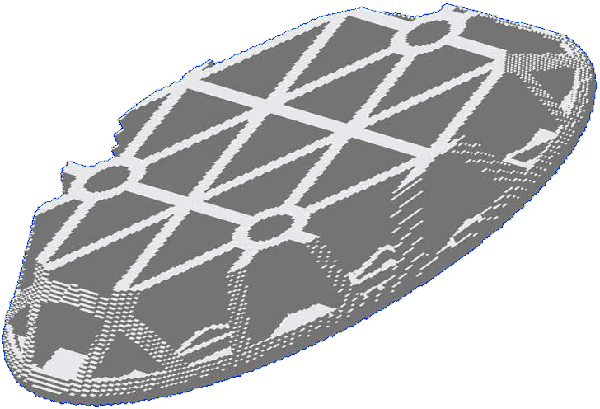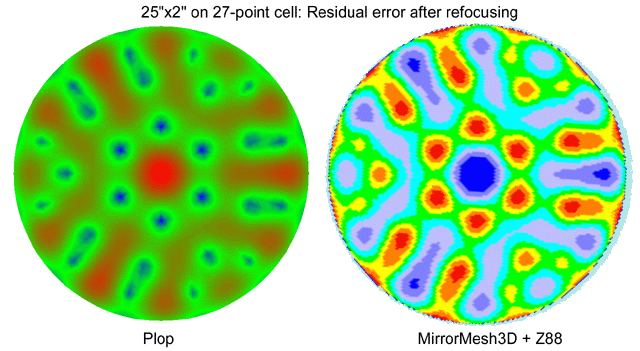|
Overview of the MirrorMesh3D method
- Background
- One of the interesting challenges of the 110 cm telescope project is the deflection analysis of the cellular mirrors,
both the 1110 mm parabolic primary and 206x291 mm flat secondary blanks.
Cellular mirrors behave quite differently compared to traditional solid mirrors. When you remove 60% to 80% of the glass, the safety margins
in the mechanical design disappear, and conventional wisdom is no longer valid. There is no point in going "cellular" if at the end of the day
the optical surface isn't capable of holding its figure!
- Overview of the MirrorMesh3D method
- To be able to analyze without too much effort a lot of variations in design parameters and the lay-out of the rib pattern,
I wrote a computer program MirrorMesh3D that generates complete 3D models of astronomical mirrors for use in the
open-source finite element package Z88.
MirrorMesh3D starts from a geometrical description of the cellular lay-out, and will automatically generate the appropriate Z88 geometry and constraint
input files. Typical mirror models are comprised of about 50,000 to 250,000 elements, like the following example for the 206x291 secondary mirror:

- Once the Z88 analysis is finished, MirrorMesh3D analyses the results and computes the resulting surface errors.
Validation of the MirrorMesh3D method - Comparison with Plop
- Plop
- David Lewis' program Plop is widely used all over the world for designing
floating point mirror cells for telescope mirrors. It's one of the biggest improvements that have appeared on the amateur telescope making
scene in the last decade.
The program uses two-dimensional plate theory to compute the deflections of a mirror surface with various support
point configurations, and automatically optimizes the support locations for minimum surface error.
- Limitations of Plop
- Plop can only handle circular mirrors that are subjected to a gravity load parallel to the mirror's optical axis, and is obviously of
no use for anything else.
MirrorMesh3D on the other hand uses a full three-dimensional analysis without any special knowledge of plate theory, and can be used for any
mirror structure including elliptical flats and cellular designs.
MirrorMesh3D can also be used for load cases other than the vertical weight, for example to validate the edge support of the mirror
that is required when the mirror points to the horizon.
- MirrorMesh3D vs. Plop
- To validate MirrorMesh3D, a solid parabolic 25"x2" f/5 mirror (635 mm diameter, 51 mm thick, 3175 mm focal length) is analyzed on
various support cells (6 points, 18 points and 27 points) in both Plop and MirrorMesh3D.
The analysis methods used by the two programs are so different that, if the results are similar, this constitutes in fact
a validation of both programs.
- Both programs perform a refocusing of the deformed surface. If a mirror deforms in a parabolic shape, the resulting focal length will be
slightly modified without generating any wave front errors. This is one of the key features of Plop that has also been programmed into MirrorMesh3D.
For flat secondary mirrors this mechanism is replaced by a tilt of the mirror.
- Benchmark 1 - 25"x2" mirror on 6 point cell
- Using a mirror diameter of 635 mm, thickness of 51 mm, focal length of 3175 mm and central obstruction of 50 mm, Plop places the
support points for a 6-point cell at radius R1=0.585664.
The surface errors computed by Plop are:
- 420 nm P-V and 127 nm RMS before refocusing
- 41.3 nm P-V and 7.9 nm RMS after refocusing.
- With MirrorMesh3D using identical support configuration, the surface errors are:
- 432 nm P-V and 138 nm RMS before refocusing
- 40.3 nm P-V and 8.1 nm RMS after refocusing
- Benchmark 2 - 25"x2" mirror on 18 point cell
- Using the same mirror on a 18 point cell, Plop places the
support points at radius R1=0.386364 and R2=0.794705.
The surface errors computed by Plop are:
- 93.5 nm P-V and 28.0 nm RMS before refocusing
- 13.6 nm P-V and 1.8 nm RMS after refocusing.
- With MirrorMesh3D using identical support configuration, the surface errors are:
- 87.9 nm P-V and 27.3 nm RMS before refocusing
- 11.1 nm P-V and 2.0 nm RMS after refocusing
- Benchmark 3 - 25"x2" mirror on 27 point cell
- Using the same mirror on a 27 point cell, Plop places the support points at radius
R1=0.319291, R2=0.649856 and R3=0.827423.
The surface errors computed by Plop are:
- 103 nm P-V and 30.5 nm RMS before refocusing
- 8.5 nm P-V and 1.2 nm RMS after refocusing.
- With MirrorMesh3D using identical support configuration, the surface errors are:
- 101 nm P-V and 31.3 nm RMS before refocusing
- 7.1 nm P-V and 1.3 nm RMS after refocusing
Below a comparison of the small residual surface deflection after the refocusing operation. Note that after refocus only about 8 nm deflection
remains from the original 100 nm, therefore magnifying greatly any difference between the two programs:

- Conclusion
- The three benchmarks show that the results of Plop and MirrorMesh3D are very similar, the differences are of the order of 5% to 10%.
One can hardly expect two programs that use such different analysis methods to come any closer than this.
| |